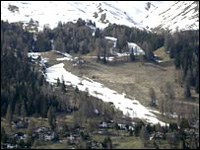News
Snowcats and man-made snow as a threat to plant diversity
May 04, 2005
/
alpMedia
The number of plant species growing on mountain slopes used for ski trails in Switzerland is eleven percent lower than on adjoining sites. The reduction is especially striking in the case of woody and early flowering plants.
That is the result of a field study into the vegetation cover at twelve ski areas in the Swiss Cantons of Grisons and Valais conducted by scientists of the Swiss Institute of Snow and Avalanche Research in Davos/CH and the Universities of Zurich/CH and Potsdam/D. The investigations show that, in spite of the revegetation measures taken, many slopes built thirty years ago - especially at high altitudes above the timber line - have still not completely recovered. Groomed ski slopes today constitute almost one percent of the total area of the Swiss Alps.
The use of artificial snow also impacts the flora. The drop in the numbers of early-flowering plants and the increase in species with a high nutrient uptake are due to the later snowmelt on the ski trails and changes in the chemical composition of the snow. In the context of climate change, researchers are concerned that ski areas will be tempted to build ski runs at increasingly higher altitudes and to make more and more use of snowmaking systems. Their conclusion is that areas of great ecological value should not be employed for such purposes and no new ski trails should be permitted.
Bibliography: "Effects of ski piste preparation on alpine vegetation" in: Journal of Applied Ecology, vol. 42, April 2005, p. 306
The use of artificial snow also impacts the flora. The drop in the numbers of early-flowering plants and the increase in species with a high nutrient uptake are due to the later snowmelt on the ski trails and changes in the chemical composition of the snow. In the context of climate change, researchers are concerned that ski areas will be tempted to build ski runs at increasingly higher altitudes and to make more and more use of snowmaking systems. Their conclusion is that areas of great ecological value should not be employed for such purposes and no new ski trails should be permitted.
Bibliography: "Effects of ski piste preparation on alpine vegetation" in: Journal of Applied Ecology, vol. 42, April 2005, p. 306


